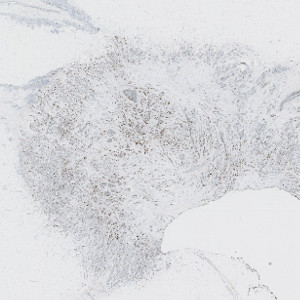
Ki-67 stained slide.


#10114
One of the more recent approaches to Ki-67 scoring is the hot spot scoring method, which has been implemented to multiple scoring guidelines, e.g. the Swedish guidelines for breast cancer, see [1], and the Danish guidelines for breast cancer, see [2]. However, this scoring method lacks standardization and is often found to be subjective and prone to both intra- and inter-observer variability, see [3]. Using the Hot spot APP a standardized method for scoring in hot spots can be obtained.
The APP is independent on biomarker and tissue type, and may be used for analysis of biomarkers different from Ki-67 and on indications different from breast cancer. The APP can be configured in numerous ways, and can be customized for different use cases. The default Hot Spot APP configuration is the same as used in article [4], where it was shown that digital image analysis of Ki-67 in hot spots is superior to both manual Ki-67 and mitotic counts in breast cancer.
Auxiliary APPs
Protocol: “01 Hot Spot Detection”
This protocol automatically creates a heatmap and places one or more hot spots based on the heatmap.
Protocol: “02 Hot Spot Quantification”
This protocol counts the nuclei present in the detected hot spot/hot spots and outputs the positive percentage for the hot spot(s).
Quantitative Output variables
The output variables obtained from this APP include:
Workflow
Step 1: Load and run the protocol “01 Hot Spot detection” on an image already processed with an analytical APP, e.g. “Ki-67, Breast Cancer”
Step 2: Load and run the protocol “02 Hot Spot Quantification” on the image already processed with “01 Hot Spot Detection”
Methods
Based on objects already identified, e.g. with the APP “Ki-67, Breast Cancer”, a heatmap is created showing the “hottest” areas on the whole slide image. The heatmap can be created based on the density of positive nuclei or based on the ratio of positive and negative nuclei. A hot spot or multiple hot spots are then automatically placed based on the information in the heatmap. A hot spot can be defined as a circle of a fixed size, a square of a fixed size, an adaptive shape, that follows the contours of the heatmap until a predefined area is reached, or as an adaptive shape following the contours of the heatmap until a predefined number of nuclei is reached (see FIGURE 3-6).
Staining Protocol
The APP is independent of the staining.
Keywords
Hot spot, Ki-67, breast cancer, image analysis, proliferation, digital pathology
References
LITERATURE
1. Regionala cancercentrum i samverkan Gällande vårdprogram bröstcancer. (Accessed: 7. Juni 2018).
2. Danish Breast Cancer Cooperative Group (DBCG) Patologiprocedurer og molekylærpatologiske analyser. (Last updated: Maj 2017).
3. Jang, M. H. et. al. A Comparison of Ki-67 Counting Methods in Luminal Breast Cancer: The Average Method vs. the Hot Spot Method, PLOS 2017, 12 (2), DOI.
4. Stålhammar, G. et. al. Digital image analysis of Ki67 in hot spots is superior to both manual Ki67 and mitotic counts in breast cancer, Histopathology 2017, 72 (6), 974-989, DOI.